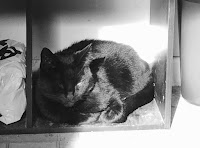What You See

We’ll start with Reese. If you’ve read It’s Normal For Me, you’ll know a little bit about him already. Reese arrived by way a gleaming single eye at the end of our laneway. He’d spent about six of his twelve months of life in the wild – a young kitten, in the winter, alone, with sutures still in his eye. Fur was missing from parts of his body and you could see that he’d developed some pretty major claws. And yet … he came up on the porch, sat with my grown children, inhaled a full piece of pizza, and looked around for more. He rubbed on them and tried to snuggle. A scrawny black cat with one eye and huge nails surely wouldn’t have many adoption prospects in a shelter lineup, but with love, Reese quickly developed into a sweet, drooly guy. He connected with our other male cat right away, and was quick to defend his little buddy. They often snuggled together – something that isn’t typical for male cats. But his favourite thing was simply to lie on me – anywhere, anyhow, and go to sleep. Having a laptop set on top of him wasn’t a problem. He just needed to be there. This rough-and-tumble looking guy was an absolute prince of affection.

Then, there’s Dusty. Dusty started life as a barn cat and first presented me with a dead mouse at just six weeks old. But even in the beginning, she knew she was pretty, and she knew she was in charge. She groomed me, bossed her brother, and ‘mothered’ various male cats in our home. She “took us for walks”, running ahead to ensure we were going into safety, and returning to lead us there again and again. No other cat dared to fight with this tiny fluffy terror who never passed eight pounds. To this day, Dusty is clear that she is in charge of our home and its inhabitants– human and feline – at her dowager weight of just five pounds. Larger, younger and stronger cats in the house even back away from their food bowls when she wanders up for a nibble. She may have been born in a barn, but Dusty has always known she is queen of the world, and in her dementia at 18, it’s something she’s not forgotten.
And, well, Spot. Spot came to us at three months of age, having spent six weeks used as a ball by an unruly four and six year old. When I picked her up, she was huddled into the corner of a huge animal carrier, left on an exposed porch in the country in the middle of winter. As a taxi company owner, my schedule was unpredictable at best and to this day, I don’t know how long she was left out there without a blanket, towel, or any shield from the wind before I got to her. She spent her first couple of days hiding behind a toilet – life hadn’t taught her much about love and kindness. It didn’t take long, though, for Spot to come out and when she did, it was with a vengeance. She wrestled constantly with her littermate Sam, who had come to us earlier. And she adored her humans. She snuggled under the covers in the bed. She sipped coffee with cream. She nibbled cold cuts from sandwiches. And most amazingly, she adored children. Small children – toddlers, that terror of most cats. Spot was the cat that a three year old could pick up and carry around – and there’s not a three-year old out there who carries a cat well. She’d tolerate that for hours, and then curl up and snuggle with them. Now at 17, Spot’s health is failing and her tolerance level isn’t what it was – but the love she gave to the many young children who progressed through our home was certainly an unexpected blessing.




Comments
Post a Comment